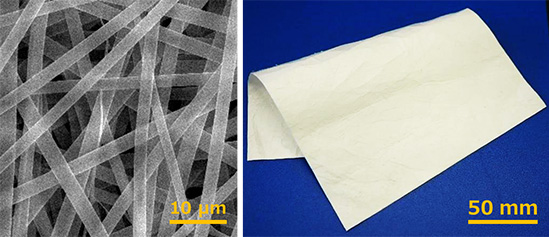Development of a Bioabsorbable Adhesive Sheet Capable of Closing Wounds in Tissues/Organs
—Use of Alaska Pollock Gelatin Increases the dressing’s Adhesiveness and Biocompatibility under Wet Conditions and May Reduce Treatment Costs—
2020.12.10
National Institute for Materials Science (NIMS)
NIMS has developed a surgical wound dressing sheet capable of closing wounds in wet biological tissues by simply being placed over a wound.
Abstract
- NIMS has developed a surgical wound dressing sheet capable of closing wounds in wet biological tissues by simply being placed over a wound. This sheet also showed biodegradability during wound healing. In addition, this sheet demonstrated higher adhesion and biocompatibility compared to currently used surgical sealants while having the same level of wound healing efficacy. The use of this sheet may also reduce treatment costs.
- Three types of medical sheets are currently available to seal surgical wounds: poly (glycolic acid) sheet, fibrin sheet and cell sheets. Although these products have proven generally effective, they also have some issues: they have poor adhesion to biological tissues under the condition in which these tissues are exposed to blood and other bodily fluids during surgery, they are inadequately biocompatible and may trigger foreign body reactions and cell sheet is expensive. Development of new surgical wound dressing sheets that can resolve these issues had been awaited.
- This research group chemically modified Alaska pollock gelatin with decanyl groups (10-carbon alkyl groups) to enhance its ability to penetrate the surface of biological tissues. The group then processed this gelatin into a sheet using an electrospinning technique. When this sheet was placed over a wound created in extracted rat lungs it firmly adhered to the lung surface. The sheet remained intact on the lung surface when the lung was inflated by the level of air pressure that could be induced by the human cough. The sheet was also observed to degrade and be absorbed within 21 days when implanted in rat subcutaneous tissue.
- This bioabsorbable sheet can facilitate wound closure in tissues and organs by simply being placed over a wound. By contrast, existing gelatinous and granular adhesives require specialized devices, such as a sprayer, for their application. This versatile, easy-to-use sheet may potentially have a wide range of surgical and internal medicine applicability. Alaska pollock skin is the source of the gelatin used to produce this sheet. It is available as a waste product of kamaboko (a processed seafood product in Japan) processing factories and is economically obtainable, potentially lowering the cost of treating surgical wounds. We plan to develop this material into a commercial medical device through collaborative research with the medical and industrial sectors.
- This project was carried out by a research team led by Tetsushi Taguchi (Group Leader, Research Center for Functional Materials, NIMS). This research was published in Biomaterials Science, an online journal, on November 25, 2020, GMT.

Figure. Surgical wound dressing sheet composed of Alaska pollock gelatin modified with decanyl groups. (Left) Microstructure. (Right) Large sheet.
Related files
- Research Center for Functional Materials
Contact information
(Regarding this research)
-
Tetsushi Taguchi
Group Leader
Polymeric Biomaterials Group
Polymers and Biomaterials Field
Research Center for Functional Materials
National Institute for Materials Science
Tel: +81-29-860-4498
E-Mail: TAGUCHI.Tetsushi=nims.go.jp
(Please change "=" to "@")
(General information)
-
Public Relations Office
National Institute for Materials Science
1-2-1 Sengen, Tsukuba, Ibaraki 305-0047, Japan
Tel: +81-29-859-2026
Fax: +81-29-859-2017
E-Mail: pressrelease=ml.nims.go.jp
(Please change "=" to "@")
Recent Press Release
-
Simultaneous Imaging of Intracellular DNA and RNA Using Harmless Light
2025.10.27
-
Development of an AI Device Using Ion Gel and Graphene That Dramatically Streamlines Machine Learning Computations
2025.10.14
-
Demonstrating a Novel Method to Modulate Heat Flow Through the Collective Motion of Spins
2025.10.06
